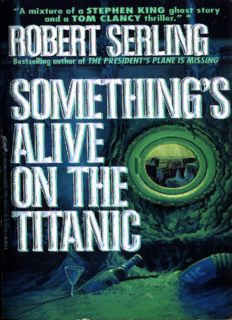Table Of ContentPraise for Something’s Alive on the Titanic:
*Library Journal
“SOMETHING’S ALIVE ON THE TITANIC works both as a fresh adventure
story and a speculative return to April 15, 1912. The narrative starts quickly. An
object of incredible value is on the Titanic, and a small group on a top-secret
mission goes after it. The plot is exciting, and Serling gives a fresh treatment to a
common 1912 reaction to the disaster: the Titanic as a morality play.”
—Arizona Daily Star
“This is definitely two books in one: a well-researched, well-written, fact-based
novel about the Titanic. And a really terrific ghost story. Serling has woven a
great tale around the Titanic, probably second only to The Flying Dutchman
when it comes to legendary ships.”
—Sunday Oklahoman
Praise for Previous Novels by Robert Serling:
THE PRESIDENT’S PLANE IS MISSING
“[Serling] knows how to stir up suspense at jet speed.”
—UPI
AIR FORCE ONE IS HAUNTED
“Takes off like a rocket and cruises smoothly to an explosive, yet sobering
climax ... Serling has spun another winner!”
—Publishers Weekly
LIFE SIGNS ... AT TWO MILES DEEP ...
There was a man standing in the center of the room—only a silhouette at first,
but becoming more distinct as Gillespie’s eyes adjusted to what his helmet light
was illuminating.
A man, very definitely. Wearing the bridge coat of the Royal Merchant
Marine. A black officer’s cap, with the White Star insignia. Under the peaked
cap was a face—square-jawed, stern, very British.
Now it was Gillespie who gasped.
On the right temple was a tiny black hole, jagged around the edges as if a
bullet had penetrated there.
Into the oceanographer’s numbed mind came the realization that he was
looking at William Murdoch, Titanic’s first officer.
Murdoch, who had been in charge of the bridge at 11:40 P.M., April 14, 1912.
Murdoch, who had given the fateful command—“Hard astarboard”—the
command that turned the ship into the hidden ice spur that ripped out her guts in
thirty seconds.
Murdoch, who, according to several eyewitnesses, had shot himself in the
temple just before the giant liner sank.
The figure was shaking its head. ...
ALSO BY ROBERT SERLING
FICTION
THE LEFT SEAT
THE PRESIDENT’S PLANE IS MISSING
WINGS
SHE’LL NEVER GET OFF THE GROUND
STEWARDESS
AIR FORCE ONE IS HAUNTED
NONFICTION
THE PROBABLE CAUSE
THE ELECTRA STORY
LOUD AND CLEAR
CEILING UNLIMITED
MAVERICK
THE ONLY WAY TO FLY
HOWARD HUGHES’ AIRLINE
FROM THE CAPTAIN TO THE COLONEL
EAGLE
COUNTDOWN (with Frank Borman)
SOMETHING’S
ALIVE ON THE
TITANIC
ROBERT SERLING
SMP
ST. MARTIN’S PAPERBACKS
NOTE: If you purchased this book without a cover you should be aware that this book is stolen property. It
was reported as “unsold and destroyed” to the publisher, and neither the author nor the publisher has
received any payment for this “stripped book.”
This novel is a work of fiction. All of the events, characters, names, and places depicted in this novel are
entirely fictitious or are used fictitiously. No representation that any statement made in this novel is true or
that any incident depicted in this novel actually occurred is intended or should be inferred by the reader.
SOMETHING’S ALIVE ON THE TITANIC
Copyright © 1990 by Robert Serling.
Cover illustration by Neal McPheeters.
All rights reserved. No part of this book may be used or reproduced in any manner whatsoever without
written permission except in the case of brief quotations embodied in critical articles or reviews. For
information address St. Martin’s Press, 175 Fifth Avenue, New York, N.Y. 10010.
Library of Congress Catalog Card Number: 90-37467
ISBN: 0-312-92999-4
Printed in the United States of America
St. Martin’s Press hardcover edition/December 1990
St. Martin’s Paperbacks edition/September 1993
10 9 8 7 6 5 4 3 2 1
Contents
Contents
Introduction
Prologue
Part One
Chapter 1
Chapter 2
Chapter 3
Chapter 4
Chapter 5
Chapter 6
Chapter 7
Chapter 8
Chapter 9
Chapter 10
Chapter 11
Part Two
Chapter 12
Chapter 13
Chapter 14
Chapter 15
Chapter 16
Chapter 17
Chapter 18
Chapter 19
Chapter 20
Chapter 21
Chapter 22
Epilogue
Author’s Postscript
About the Author
I have never had the privilege of meeting
this man of great integrity and sensitivity,
but, nevertheless, this book is dedicated to:
Dr. Robert D. Ballard,
discoverer of the Titanic
“In future, when I think of the Titanic,
I will see her bow sitting on the bottom,
dignified despite the decay and, finally, at rest.”
—Dr. Robert D. Ballard
“Do I believe in ghosts? No, but
I’m afraid of them.”
—Marquise du Deffand
Introduction
Her life was tragically brief; her death, immortal.
On April 14, 1912, the Royal Mail Steamer R. M. S. Titanic, on the fourth
night of her maiden voyage from Southampton, England, to New York, struck an
iceberg and sank two and a half hours later.
She carried 1,320 passengers and 908 crew members. When she went down,
her sixteen lifeboats left 826 passengers and 697 crew members behind to die.
Not for nearly eight decades were human eyes to look upon the remains of
what was once the world’s biggest, most palatial ocean liner—at the time “the
largest moving object ever created by man,” her builders proudly proclaimed. In
the 1980s, three separate expeditions finally located the Titanic, and much of the
mystery and conjecture still surrounding her final moments of agony were at last
explained.
Possibly.
For this is a story of what might have happened.

